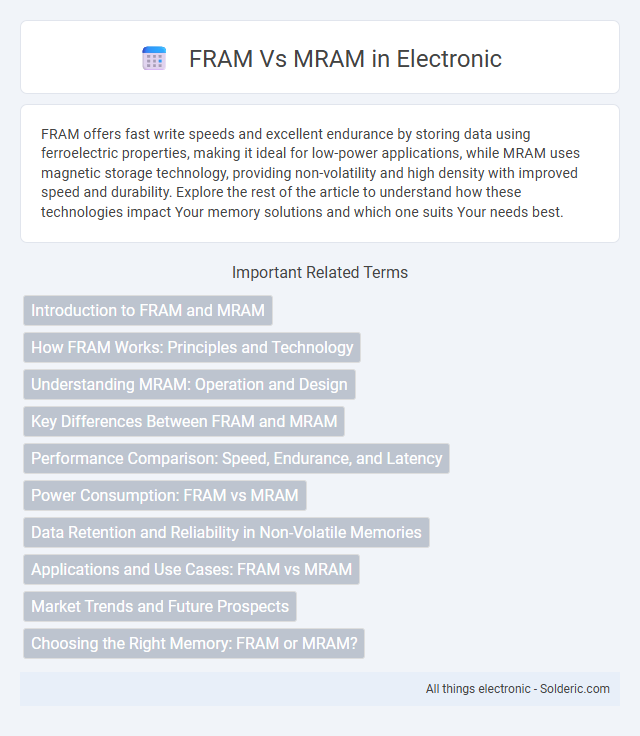FRAM offers fast write speeds and excellent endurance by storing data using ferroelectric properties, making it ideal for low-power applications, while MRAM uses magnetic storage technology, providing non-volatility and high density with improved speed and durability. Explore the rest of the article to understand how these technologies impact Your memory solutions and which one suits Your needs best.
Comparison Table
| Feature | FRAM (Ferroelectric RAM) | MRAM (Magnetoresistive RAM) |
|---|---|---|
| Technology | Ferroelectric polarization | Magnetic tunnel junctions |
| Data Retention | Non-volatile, up to 10 years | Non-volatile, over 10 years |
| Write Speed | Fast, typically < 200 ns | Very fast, < 10 ns |
| Endurance | High endurance, > 10^12 cycles | Extremely high endurance, > 10^15 cycles |
| Power Consumption | Low write power | Ultra-low power, especially in standby |
| Density | Moderate, limited by ferroelectric material | High, scalable with advanced technology |
| Applications | Embedded systems, low-power devices | Universal memory, cache, storage-class memory |
| Temperature Stability | Moderate, affected by high temperatures | High, stable over wide temperature range |
Introduction to FRAM and MRAM
FRAM (Ferroelectric Random Access Memory) uses ferroelectric layers to store data by polarization states, enabling fast write speeds and high endurance with low power consumption. MRAM (Magnetoresistive Random Access Memory) relies on magnetic tunnel junctions to store information through electron spin, offering non-volatility, high speed, and excellent scalability. Both FRAM and MRAM provide non-volatile memory solutions, with FRAM excelling in low-power applications and MRAM favored for high-density storage and durability.
How FRAM Works: Principles and Technology
FRAM (Ferroelectric Random Access Memory) operates by utilizing a ferroelectric layer that maintains data through the orientation of electric dipoles within a crystalline structure, enabling non-volatile storage. Its core technology relies on polarization states that can be reversed by applying an electric field, allowing fast write and read cycles with low power consumption. This unique mechanism distinguishes FRAM from MRAM, which uses magnetic tunnel junctions to store data magnetically rather than electrically.
Understanding MRAM: Operation and Design
MRAM (Magnetoresistive Random-Access Memory) operates by storing data using magnetic tunnel junctions, where resistance changes indicate binary states, offering non-volatility and high endurance. Its design leverages spintronics, enabling fast read/write speeds and low power consumption compared to traditional RAM technologies. Understanding MRAM's operation helps you appreciate its potential in replacing FRAM, especially in applications demanding durability and speed.
Key Differences Between FRAM and MRAM
FRAM (Ferroelectric RAM) uses ferroelectric materials to store data by polarization states, offering ultra-low power consumption and high endurance with fast write speeds. MRAM (Magnetoresistive RAM) stores data through magnetic states using magnetic tunnel junctions, providing non-volatility, high speed, and superior data retention at elevated temperatures. Key differences include FRAM's faster write cycles and lower power usage versus MRAM's scalability, higher density potential, and better non-volatility for long-term data storage.
Performance Comparison: Speed, Endurance, and Latency
FRAM offers ultra-fast write speeds in the order of nanoseconds and extremely high endurance exceeding 10^12 write cycles, making it ideal for frequent data logging applications. MRAM features low latency read and write operations with speeds comparable to SRAM, while providing endurance typically around 10^15 cycles, suitable for non-volatile cache memory. Both technologies excel in speed and endurance compared to traditional flash memory, but MRAM generally delivers lower latency and higher durability under intensive write conditions.
Power Consumption: FRAM vs MRAM
FRAM (Ferroelectric RAM) consumes significantly less power during write operations compared to MRAM (Magnetoresistive RAM), making it ideal for low-power applications. MRAM, while generally more power-efficient than traditional SRAM and DRAM, requires higher write currents due to the magnetization switching mechanism. This difference in power consumption impacts battery life and thermal management in embedded systems and IoT devices.
Data Retention and Reliability in Non-Volatile Memories
FRAM (Ferroelectric RAM) exhibits superior data retention with endurance reaching 10^14 write cycles and stable operation at high temperatures, making it highly reliable for long-term data storage. MRAM (Magnetoresistive RAM) offers robust data retention due to magnetic tunnel junctions that maintain magnetic states without power, ensuring non-volatility even under extreme environmental conditions. Both technologies provide enhanced reliability compared to traditional flash memory, but FRAM excels in ultra-high endurance while MRAM delivers greater resistance to radiation and harsh environments.
Applications and Use Cases: FRAM vs MRAM
FRAM excels in applications requiring high-speed write performance and ultra-low power consumption, making it ideal for smart cards, RFID systems, and energy-efficient sensors. MRAM is well-suited for high-density storage and non-volatile memory in automotive electronics, aerospace, and advanced computing due to its durability and resistance to radiation. Your choice between FRAM and MRAM depends on whether you prioritize fast write cycles and low power (FRAM) or high endurance and scalability (MRAM) for specific use cases.
Market Trends and Future Prospects
FRAM (Ferroelectric RAM) and MRAM (Magnetoresistive RAM) are gaining significant traction in non-volatile memory markets due to their low power consumption and high endurance. Market trends indicate MRAM's growing adoption in embedded systems and automotive applications, driven by scalability and fast write speeds, while FRAM maintains a strong niche in industrial and sensor applications for its ultra-fast read/write cycles and radiation resistance. Future prospects highlight MRAM's potential to challenge Flash memory in data storage, whereas FRAM is expected to expand within IoT devices requiring reliable, low-latency memory solutions.
Choosing the Right Memory: FRAM or MRAM?
FRAM offers ultra-fast write speeds and low power consumption, making it ideal for applications requiring frequent data logging and energy efficiency. MRAM provides superior endurance and non-volatility, suitable for high-performance storage and instant-on computing needs. Selecting between FRAM and MRAM depends on specific use cases such as write cycle requirements, power constraints, and long-term data retention priorities.
FRAM vs MRAM Infographic

 solderic.com
solderic.com